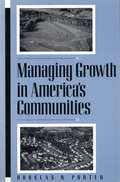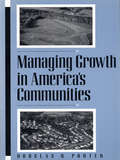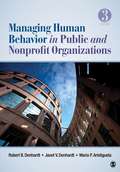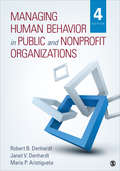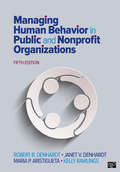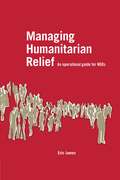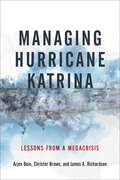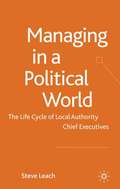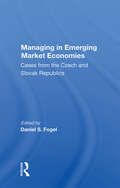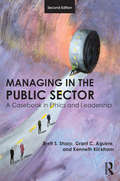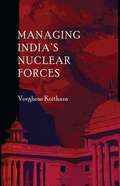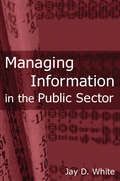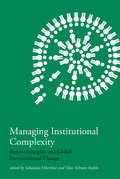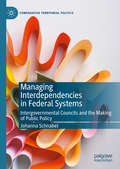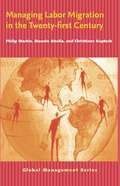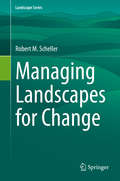- Table View
- List View
Managing Government Employees: How to Motivate Your People, Deal with Difficult Issues, and Achieve Tangible Results
by Stewart LiffManaging government employees presents unique challenges. Government managers may feel that stringent and convoluted regulations mean they "can't do that". Some others may use that perception as a crutch. But the truth for all of them is, yes, they can "do that" -- and they'd better. "That" means managing employees as proactively and decisively as their corporate counterparts, and holding their staffs, teams, and departments accountable for productivity and results. Managing Government Employees offers dozens of techniques for meeting the challenges and stressful situations supervisers face on a daily basis. Major topics include how to: * get maximum dedication and productivity from employees * improve results of poor performers and discipline or fire them when necessary * deal with union and EEO issues * cut through the red tape of government employment systems For managers frustrated by government bureaucracy, this book lets them know they have more power than they may think.
Managing Great Power Politics: ASEAN, Institutional Strategy, and the South China Sea (Global Political Transitions)
by Kei KogaThis Open Access book explains ASEAN’s strategic role in managing great power politics in East Asia. Constructing a theory of institutional strategy, this book argues that the regional security institutions in Southeast Asia, ASEAN and ASEAN-led institutions have devised their own institutional strategies vis-à-vis the South China Sea and navigated the great-power politics since the 1990s. ASEAN proliferated new security institutions in the 1990s and 2000s that assumed a different functionality, a different geopolitical scope, and thus a different institutional strategy. In so doing, ASEAN formed a “strategic institutional web” that nurtured a quasi-division of labor among the institutions to maintain relative stability in the South China Sea. Unlike the conventional analysis on ASEAN, this study disaggregates “ASEAN” as a collective regional actor into specific individual institutions—ASEAN Foreign Ministers’ Meeting, ASEAN Summit, ASEAN-China dialogues, ASEAN Regional Forum, East Asia Summit, and ASEAN Defense Ministers Meeting and ASEAN Defense Ministers Meeting-Plus—and explains how each of these institutions has devised and/or shifted its institutional strategy to curb great powers’ ambition in dominating the South China Sea while navigating great power competition. The book sheds light on the strategic potential and limitations of ASEAN and ASEAN-led security institutions, offers implications for the future role of ASEAN in the Indo-Pacific region, and provides an alternative understanding of the strategic utilities of regional security institutions.
Managing Growth in America's Communities: Second Edition
by Douglas R. PorterCommunities across the country are turning to the concept of "growth management" to help plan for the future, as they seek to control the location, impact, character and timing of development in order to balance environmental and economic needs and concerns. Managing Growth in America's Communities presents practical information about proven strategies, programs and techniques of growth management for urban and rural communities. Topics examined include: public roles in community development determining locations and character of future development protecting environmental and natural resources managing infrastructure development preserving community character and quality achieving economic and social goals property rights concerns The author describes regulatory and programmatic techniques that have been most useful, obstacles to be overcome, and specific strategies that have been instrumental in achieving successful growth management programs. He provides examples from dozens of communities across the country as well as state and regional approaches currently in use. Brief profiles present overviews of problems addressed, techniques implemented, outcomes, and contact information for conducting further research. Among the communities profiled are Arlington County, Virginia; Fort Collins, Colorado; Lexington-Fayette County, Kentucky; Lincoln, Nebraska; Sarasota, Florida; Raleigh, North Carolina; Scottsdale, Arizona; and numerous others. Also included in the volume are informational sidebars written by leading experts in growth management including Robert Yaro, John De Grove, David Brower, and others.Managing Growth in America's Communities is essential reading for community development specialists including government officials, planners, environmentalists, designers, developers, business people, and concerned citizens seeking innovative and feasible ways to manage growth.
Managing Growth in America's Communities: Second Edition
by Douglas R. PorterIn this thoroughly revised edition of Managing Growth in America's Communities, readers will learn the principles that guide intelligent planning for communities of any size, grasp the major issues in successfully managing growth, and discover what has actually worked in practice (and where and why). This clearly written book details how American communities have grappled with the challenges of planning for growth and the ways in which they are adapting new ideas about urban design, green building, and conservation. It describes the policies and programs they have implemented, and includes examples from towns and cities throughout the U.S.Growth management is essential today, as communities seek to control the location, impact, character, and timing of development in order to balance environmental and economic needs and concerns.The author, who is one of the nation's leading authorities on managing community growth, provides examples from dozens of communities across the country, as well as state and regional approaches. Brief profiles present overviews of specific problems addressed, techniques utilized, results achieved, and contact information for further research. Informative sidebars offer additional perspectives from experts in growth management, including Robert Lang, Arthur C. Nelson, Erik Meyers, and others.In particular, he considers issues of population growth, eminent domain, and the importance of design, especially green design. He also reports on the latest ideas in sustainable development, smart growth, neighborhood design, transit-oriented development, and green infrastructure planning. Like its predecessor, the second edition of Managing Growth in America's Communities is essential reading for anyone who is interested in how communities can grow intelligently.
Managing Human Behavior in Public and Nonprofit Organizations
by Maria P. Aristigueta Robert B. Denhardt Janet V. DenhardtThe only text in management and organizational behavior to focus on public organizations, nonprofit organizations, and school systems, Managing Human Behavior in Public and Nonprofit Organizations fosters competency in critical management and leadership skills including communication, motivation, teamwork, group dynamics, and decision-making. Cases, self-assessment exercises, simulations, and evaluative instruments provide students the opportunity to experience the applied side of theories and to learn both cognitively and experientially. The Third Edition covers recent developments in the field including the emergence of "positive organizational behavior. "
Managing Human Behavior in Public and Nonprofit Organizations
by Robert B. Denhardt Janet V. Denhardt Dr Maria P. AristiguetaA must-read for students in public administration and nonprofit management programs! Managing Human Behavior in Public and Nonprofit Organizations, Fourth Edition, is designed to help students understand, manage, and influence the behavior of others in the workplace. Esteemed authors Robert B. Denhardt, Janet V. Denhardt, and Maria P. Aristigueta take an action-oriented approach by using real-world circumstances within public and nonprofit organizations to illustrate key concepts. Important topics such as stress, decision making, motivation, leadership, communication, teams, and change give students a foundational understanding of the basic issues that affect human behavior. In addition to new cases and examples from the public and nonprofit sectors, the Fourth Edition features new material on leadership and organizational change, cultural diversity and generational diversity, and positive organizational behavior.
Managing Human Behavior in Public and Nonprofit Organizations
by Robert B. Denhardt Janet V. Denhardt Dr Maria P. AristiguetaA must-read for students in public administration and nonprofit management programs! Managing Human Behavior in Public and Nonprofit Organizations, Fourth Edition, is designed to help students understand, manage, and influence the behavior of others in the workplace. Esteemed authors Robert B. Denhardt, Janet V. Denhardt, and Maria P. Aristigueta take an action-oriented approach by using real-world circumstances within public and nonprofit organizations to illustrate key concepts. Important topics such as stress, decision making, motivation, leadership, communication, teams, and change give students a foundational understanding of the basic issues that affect human behavior. In addition to new cases and examples from the public and nonprofit sectors, the Fourth Edition features new material on leadership and organizational change, cultural diversity and generational diversity, and positive organizational behavior.
Managing Human Behavior in Public and Nonprofit Organizations
by Robert B. Denhardt Janet V. Denhardt Dr Maria P. Aristigueta Kelly C. RawlingsManaging Human Behavior in Public and Nonprofit Organizations, Fifth Edition is an established core text designed to help you develop your leadership and management skills. Bestselling authors Denhardt, Denhardt, Aristigueta, and Rawlings cover important topics such as stress, decision-making, motivation, leadership, teams, communication, and change. Cases, self-assessment exercises, and numerous examples provide you with the opportunity to apply concepts and theories discussed in the chapter. Focusing exclusively on organizational behavior in both public and nonprofit organizations, this text is a must-read for students in public administration programs. New to the Fifth Edition: Increased attention to issues related to nonprofit organizations helps you develop a better understanding of the differences and similarities in public and nonprofit organizations, as well as the way they interact with one another and with the private sector. Broadened coverage of issues related to ethics and diversity offers you a broader perspective on important issues to consider, such as the examination of implicit and explicit bias, generational differences, and power and privilege. Additional discussions of collaboration, inclusion, and participation, both within the organization and with external constituencies, show you the value rationale for engagement and its practical effects. Revised and updated information on emerging technology illustrates to you how an increasingly digital, connected, and networked environment affects our ability to manage public and nonprofit organizations. New cases, examples, self-assessments, and exercises cover recent developments in research and practice to offer relevant ways for you to practice and improve your management skills.
Managing Human Behavior in Public and Nonprofit Organizations
by Robert B. Denhardt Janet V. Denhardt Dr Maria P. Aristigueta Kelly C. RawlingsManaging Human Behavior in Public and Nonprofit Organizations, Fifth Edition is an established core text designed to help you develop your leadership and management skills. Bestselling authors Denhardt, Denhardt, Aristigueta, and Rawlings cover important topics such as stress, decision-making, motivation, leadership, teams, communication, and change. Cases, self-assessment exercises, and numerous examples provide you with the opportunity to apply concepts and theories discussed in the chapter. Focusing exclusively on organizational behavior in both public and nonprofit organizations, this text is a must-read for students in public administration programs. New to the Fifth Edition: Increased attention to issues related to nonprofit organizations helps you develop a better understanding of the differences and similarities in public and nonprofit organizations, as well as the way they interact with one another and with the private sector. Broadened coverage of issues related to ethics and diversity offers you a broader perspective on important issues to consider, such as the examination of implicit and explicit bias, generational differences, and power and privilege. Additional discussions of collaboration, inclusion, and participation, both within the organization and with external constituencies, show you the value rationale for engagement and its practical effects. Revised and updated information on emerging technology illustrates to you how an increasingly digital, connected, and networked environment affects our ability to manage public and nonprofit organizations. New cases, examples, self-assessments, and exercises cover recent developments in research and practice to offer relevant ways for you to practice and improve your management skills.
Managing Humanitarian Relief: An Operational Guide for NGOs
by Eric JamesResponding effectively to humanitarian disasters is far from straightforward, and relief workers often find themselves working in competitive situations or at cross purposes with other agencies. Managing Humanitarian Relief is aimed at relief workers charged with putting together a program of action to help people in extreme crisis. It provides humanitarian relief managers with a single comprehensive reference for all the management issues they are likely to encounter in the field. The book is organized in two parts. First, it provides an outline of different relief programming sectors: food and nutrition, health, water and sanitation, and shelter. Second, it presents 20 separate management topics that are essential for overseeing programs. Its easy-to-use format includes checklists, tables, diagrams, sample forms, and no-nonsense tips from practitioners to help readers in emergency situations.
Managing Hurricane Katrina: Lessons from a Megacrisis
by Arjen Boin Christer Brown Professor James A. RichardsonThe government’s response to Hurricane Katrina, one of the most devastating natural disasters in U.S. history, suffered numerous criticisms. Nearly every assessment pointed to failure, from evaluations of President George W. Bush, FEMA, and the Department of Homeland Security to the state of Louisiana and the city administration of New Orleans. In Managing Hurricane Katrina: Lessons from a Megacrisis, Arjen Boin, Christer Brown, and James A. Richardson deliver a more nuanced examination of the storm’s aftermath than the ones anchored in public memory, and identify aspects of management that offer more positive examples of leadership than bureaucratic and media reports indicated. Katrina may be the most extensively studied disaster to date, but the authors argue that many academic conclusions are inaccurate or contradictory when examined in concert. Drawing on insights from crisis and disaster management studies, Boin, Brown, and Richardson apply a clear framework to objectively analyze the actions of various officials and organizations during and after Katrina. They specify critical factors that determine the successes and failures of a societal response to catastrophes and demonstrate how to utilize their framework in future superdisasters. Going beyond previous assessments, Managing Hurricane Katrina reconsiders the role of government in both preparing for a megacrisis and building an effective response network at a time when citizens need it most.
Managing in a Political World
by Steve LeachSteve Leach identifies the key challenges facing chief executives in British local government in operating in an environment where party politics is a dominant force. It discusses the basis on which chief executives apply for posts and manage the interview process, and the importance of the 'honeymoon period' - the first 6-9 months.
Managing In Emerging Market Economies: Cases From The Czech And Slovak Republics
by Daniel S FogelSince 1989, east-central Europe has plunged headlong into reform efforts, and firms large and small have been forced almost overnight to adapt to the demands of a market economy. This book of case studies on business development in the Czech and Slovak Republics illustrates how various industries and specific companies are responding to the challen
Managing in the Public Sector: A Casebook in Ethics and Leadership
by Brett Sharp Grant Aguirre Kenneth KickhamCasebooks in public administration have become intensely sophisticated with complex scenarios, richly detailed multi-step simulations, and demanding role playing requirements. While these types of cases and exercises have their place, Managing in the Public Sector is a casebook designed with maximum instructor flexibility and student engagement in mind. Featuring cases brief enough to be covered in the last few minutes of a class as well as those substantive enough to last the entire hour, this book allows instructors to illustrate theoretical concepts, encourage active student participation, to make a transition between topics, or to integrate different approaches to administrative study. Retaining the first edition’s use of focused, real-life-inspired cases to help elucidate the application of concepts for students, the second edition has been updated and revised throughout to include: An expanded chapter on ethical analysis A new section on how to make logical arguments Thoroughly updated cases as well as many new contemporary cases New chapter introductions featuring overviews of major leadership and ethical theories to provide students with the context they need Discussion questions at the end of each case to facilitate critical analysis and classroom discussion A cross-listing of all cases and subject matter in an appendix for quick topical reference. Now even more enmeshed in the literature of ethics, leadership, and public administration, Managing in the Public Sector, 2e provides authentic, hands-on experience of the decisions public administrators must face. It is an ideal casebook to supplement undergraduate and graduate public administration, leadership, human resource management, or administrative ethics courses.
Managing India's Nuclear Forces
by Verghese KoitharaIndia is now enmeshed in the deterrence game-actively with its traditional adversary Pakistan, and potentially with China. At the same time it is finding easier access to fissile materials and strategic technologies. In order to deal with these developments safely and wisely, the nation needs a much more sophisticated and multidisciplinary understanding of the strategic, technological, operational, and cost issues involved in nuclear matters.In this important book, Indian strategic analyst Verghese Koithara explains and evaluates India's nuclear force management, encouraging a broad public conversation that may act as a catalyst for positive change before the subcontinent experiences unthinkable carnage.The defense management system of a nuclear power absolutely needs to be sound and thorough. In addition to the considerable demands of managing its nuclear forces, it also must control conventional forces in a manner that forestalls nuclear escalation of a conflict by either side. Expanding and upgrading nuclear forces without enhancing deterrence is dangerous and should be avoided. India's nuclear force management system is grafted onto a woefully inadequate overall system of defense management.Koithara dissects all of these issues and suggests a way forward, drawing on recent developments in deterrence theory around the world.
Managing India's Nuclear Forces
by Verghese KoitharaIndia is now enmeshed in the deterrence game--actively with its traditional adversary Pakistan, and potentially with China. At the same time it is finding easier access to fissile materials and strategic technologies. In order to deal with these developments safely and wisely, the nation needs a much more sophisticated and multidisciplinary understanding of the strategic, technological, operational, and cost issues involved in nuclear matters.In this important book, Indian strategic analyst Verghese Koithara explains and evaluates India's nuclear force management, encouraging a broad public conversation that may act as a catalyst for positive change before the subcontinent experiences unthinkable carnage. The defense management system of a nuclear power absolutely needs to be sound and thorough. In addition to the considerable demands of managing its nuclear forces, it also must control conventional forces in a manner that forestalls nuclear escalation of a conflict by either side. Expanding and upgrading nuclear forces without enhancing deterrence is dangerous and should be avoided. India's nuclear force management system is grafted onto a woefully inadequate overall system of defense management.Koithara dissects all of these issues and suggests a way forward, drawing on recent developments in deterrence theory around the world.
Managing Information in the Public Sector
by Jay D WhiteThis first-of-its-kind survey covers both the basics of information technology and the managerial and political issues surrounding the use of these technologies. Unlike other works on information systems, this book is written specifically for the public sector and addresses unique public sector issues and concerns. The technical basics are explained in clear English with as little technical jargon as possible so that readers can move on to informed analysis of the public policy issues surrounding government's use of MIS. This practical tool includes end of chapter summaries with bridges to upcoming chapters, numerous boxed exhibits, thorough end-of-chapter notes and a bibliography for further reading.
Managing Instability in Algeria: Elites and Political Change since 1995 (History and Society in the Islamic World)
by Isabelle WerenfelsThis topical new book seeks to understand the relationship between elite dynamics and strategies and the lack of profound political change in Algeria after 1995, when the country’s military rulers returned to electoral processes. Using evidence from extensive fieldwork, Isabelle Werenfels exposes successful survival strategies of an opaque authoritarian elite in a changing domestic and international environment. The main focus is on: the changing balance of power between different elite segments the modes of generation change and the different emerging young elite types constraints, obligations and opportunities arising from elite embeddings in clienteles networks and in specific social and economic structures. Building rare evidence from fieldwork into a multidisciplinary analytical framework, this book presents a significant input to the more general literature on transition processes and is particularly relevant as the West pushes for democratic reforms in the Middle East and North Africa.
Managing Institutional Complexity: Regime Interplay and Global Environmental Change
by Sebastian Oberthür Olav Schram StokkeExperts investigate how states and other actors can improve inter-institutional synergy and examine the complexity of overlapping environmental governance structures.Institutional interaction and complexity are crucial to environmental governance and are quickly becoming dominant themes in the international relations and environmental politics literatures. This book examines international institutional interplay and its consequences, focusing on two important issues: how states and other actors can manage institutional interaction to improve synergy and avoid disruption; and what forces drive the emergence and evolution of institutional complexes, sets of institutions that cogovern particular issue areas.The book, a product of the Institutional Dimensions of Global Environmental Change research project (IDGEC), offers both theoretical and empirical perspectives. Chapters range from analytical overviews to case studies of institutional interaction, interplay management, and regime complexes in areas including climate change, fisheries management, and conservation of biodiversity. Contributors discuss such issues as the complicated management of fragmented multilateral institutions addressing climate change; the possible “chilling effect” on environmental standards from existing commitments; governance niches in Arctic resource protection; the relationships among treaties on conservation and use of plant genetic resources; causal factors in cross-case variation of regime prevalence; and the difficult relationship between the World Trade Organization and multilateral environmental agreements. The book offers a broad overview of research on interplay management and institutional complexes that provides important insights across the field of global environmental governance.
Managing Institutional Complexity
by Sebastian Oberthür Olav Schram StokkeInstitutional interaction and complexity are crucial to environmental governance and are quickly becoming dominant themes in the international relations and environmental politics literatures. This book examines international institutional interplay and its consequences, focusing on two important issues: how states and other actors can manage institutional interaction to improve synergy and avoid disruption; and what forces drive the emergence and evolution of institutional complexes, sets of institutions that cogovern particular issue areas. The book, a product of the Institutional Dimensions of Global Environmental Change research project (IDGEC), offers both theoretical and empirical perspectives. Chapters range from analytical overviews to case studies of institutional interaction, interplay management, and regime complexes in areas including climate change, fisheries management, and conservation of biodiversity. Contributors discuss such issues as the complicated management of fragmented multilateral institutions addressing climate change; the possible "chilling effect" on environmental standards from existing commitments; governance niches in Arctic resource protection; the relationships among treaties on conservation and use of plant genetic resources; causal factors in cross-case variation of regime prevalence; and the difficult relationship between the World Trade Organization and multilateral environmental agreements. The book offers a broad overview of research on interplay management and institutional complexes that provides important insights across the field of global environmental governance.
Managing Interdependencies in Federal Systems: Intergovernmental Councils and the Making of Public Policy (Comparative Territorial Politics)
by Johanna SchnabelIntergovernmental councils have emerged as the main structures through which the governments of a federation coordinate public policy making. In a globalized and complex world, federal actors are increasingly interdependent. This mutual dependence in the delivery of public services has important implications for the stability of a federal system: policy problems concerning more than one government can destabilize a federation, unless governments coordinate their policies. This book argues that intergovernmental councils enhance federal stability by incentivizing governments to coordinate, which makes them a federal safeguard. By comparing reforms of fiscal and education policy in Australia, Canada, Germany, and Switzerland, this book shows that councils’ effectiveness as one of federalism’s safeguards depends on their institutional design and the interplay with other political institutions and mechanisms. Federal stability is maintained if councils process contentious policy problems, are highly institutionalized, are not dominated by the federal government, and are embedded in a political system that facilitates intergovernmental compromising and consensus-building.
Managing IoT Systems for Institutions and Cities (Internal Audit and IT Audit)
by Chuck BensonThis book defines what IoT Systems manageability looks like and what the associated resources and costs are of that manageability. It identifies IoT Systems performance expectations and addresses the difficult challenges of determining actual costs of IoT Systems implementation, operation, and management across multiple institutional organizations. It details the unique challenges that cities and institutions have in implementing and operating IoT Systems.
Managing Labor Migration in the Twenty-first Century
by Philip Martin Manolo Abella Christiane KuptschWhy have ninety million workers around the globe left their homes for employment in other countries? What can be done to ensure that international labor migration is a force for global betterment? This groundbreaking book presents the most comprehensive analysis of the causes and effects of labor migration available, and it recommends sensible, sustainable migration policies that are fair to migrants and to the countries that open their doors to them. The authors survey recent trends in international migration for employment and demonstrate that the flow of authorized and illegal workers over borders presents a formidable challenge in countries and regions throughout the world. They note that not all migration is from undeveloped to developed countries and discuss the murky relations between immigration policies and politics. The book concludes with specific recommendations for justly managing the world's growing migrant workforce.
Managing Land Use Conflicts: Case Studies in Special Area Management
by David J. Brower Daniel S. CarolThis work contains a series of case studies of the planning phenomenon that has become known as Special Area Management (SAM)--those areas so naturally valuable, so important for human use, so sensitive to impact, or so particular in their planning requirements as to need special management treatment. Based on an examination of the SAMs, this work integrates various aspects of the process of their planning and management and proposes policy and administrative guidelines to improve SAMs as a planning tool.
Managing Landscapes for Change (Landscape Series #27)
by Robert M. SchellerThis book discusses how future landscapes will be shaped by pervasive change and where, when, and how society should manage landscapes for change. Readers will learn about the major anthropogenic drivers of landscape change, including climate change and human induced disturbance regimes, and the unique consequences that multiple and simultaneously occurring change agents can have on landscapes. The author uses landscape trajectories as a guide to selecting the appropriate course of action, and considers how landscape position, inertia, and direction will determine landscape futures. The author introduces the concept of landscapes as socio-technical-ecological systems (STES), which combines ecological and technological influences on future landscape change and the need for society to acknowledge both when considering landscape management. Thinking beyond solutions, the author identifies barriers to managing landscapes for change including the cost, cultural identity of local populations, and the fear of taking action under uncertain conditions. Nevertheless, processes, tools, and technologies exist for overcoming social and ecological barriers to managing landscapes for change, and continued investment in social and scientific infrastructure holds out hope for maintaining our landscape values even as we enter an era of unprecedented change and disruption.


